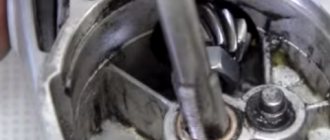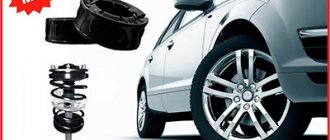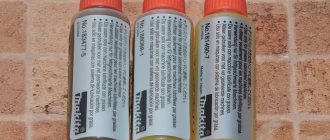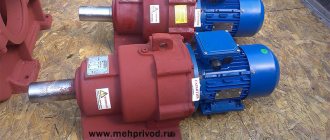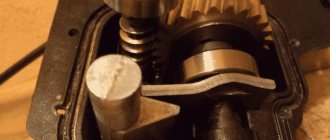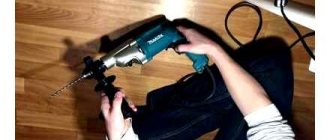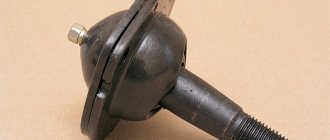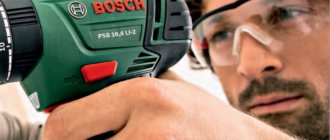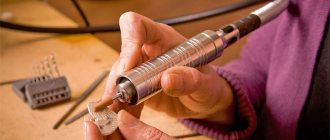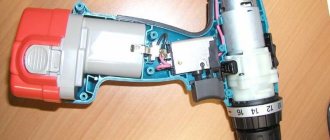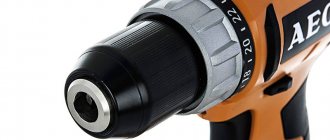What and how to properly lubricate a drill?
What is the best way to lubricate an old Soviet-made drill?
the main thing is that before lubricating all parts of the gearbox, you need to remove the old grease and wash all the parts (except for the bearings). Well, then you can lubricate, as other opponents have already said, with lithol or graphite lubricant. it more or less reduces the wear and tear of all parts. and at a price it is more affordable for most. And it is imperative to coat the part of the drill or drill that is inserted into the cartridge or barrel. This prevents the base of the cartridge or the striker from breaking in the perforated drill.
For Soviet equipment, no better lubricant than Litol-24 has been invented; it must be put into the gearbox and lubricate the guides and gears in Soviet, and not only Soviet, equipment.
Naturally, before lubrication, you need to thoroughly clean and wipe all parts dry (no need to wash with solvent, diesel fuel, or gasoline!) , just clean and wipe dry.
Place and apply fresh Litol-24 and assemble - that’s all!
Litol-24 lubricant will withstand high speeds and increased temperatures and increased loads and friction, it is put into the gearbox in quite a large volume, as the experts say - the excess will come out!, so its work is designed for a long time, and replacement is actually only during repairs.
In Soviet times, both people and technology were not spoiled by delicacies - they grabbed what they gave.
So you can treat your veteran drill with what remains from Soviet times - even simple grease.
Among modern lubricants for gear mechanisms, you can use CV joint grease (motorists know what it is), lithol. Bosch lubricants have proven themselves well in gear drives.
If you're lucky and come across this
buy without hesitation.
When servicing the drill, do not miss this moment: remove, as thoroughly as possible, all the old lubricant, because there will probably be metal particles from the gears and other dirt that have penetrated inside the tool.
There are a lot of types of drills, both by purpose (impact, hammerless, drill-mixers, etc.) and by type of power, these include manual, electric and pneumatic.
Drills also differ in power and in the number of revolutions it can produce.
Manufacturers are different, many manufacturers produce their own lubricants and recommend using only them.
In any case, in order to lubricate the drill (its gearbox), you need to get to it (the gearbox).
There are also a lot of options here, perhaps your drill needs to be “split” into two parts (I’m talking about the body, unscrew the screws that secure the body).
Before us is a gearbox
It is not necessary to disassemble it into its components.
They removed the old lubricant (although this is not always done), thoroughly cleaned it of the old lubricant (a rag is convenient), put in a new one, in general, that’s all, there are no difficulties here.
an old Soviet-made drill?
Albina always lubricated his “ancient” Soviet drill with Litol-24, there was no thought of switching to something more “advanced”, the lubricant was completely satisfactory.
Requirements for lubricating fluids for angle grinder gearboxes
The master decides for himself how to lubricate the grinder gearbox. There is no universal remedy - you need to select your own liquid for a specific tool. A properly selected lubricant must meet a number of requirements, including:
- be resistant to corrosion;
- consist of natural components - including ensuring that it does not harm the artist when inhaling vapors;
- reduce the friction force of gears, and, accordingly, the heating temperature of the tool;
- the consistency should be thick enough to stick to the parts, but with a viscosity not higher than 800 Pa s;
- the consistency must remain stable and not change, “melt” or flow out of the mechanism when the temperature rises - the minimum dropping temperature is +120ºС;
- ensure the operation of the tool in the range of up to +150 ºС;
- The presence of metal impurities in the composition is not allowed;
- tensile strength of at least 120 Pa;
- be hydrophobic, have water-repellent properties;
- protect the “insides” from dirt and dust.
Review of lubricants for grinders
If you lubricate a working tool with lithol or grease, saving on materials, there is a high probability that, ultimately, the equipment will refuse to work properly, no matter how high quality it is.
Some resources claim that preparing a liquid that satisfies all of the above points will not be difficult even at home. In one case, it is recommended to use lubricant for SDC in combination with MS-20 oil, in another case it is proposed to use a mixture of substances Tsiatim-221 and TAD-17. Despite numerous positive reviews, in both cases the consequences can be unpredictable - the manufacturer hardly took into account the possibility of filling the gearbox of a technical device with compounds that were not reassigned for it.
Foreign companies recommend to craftsmen how to lubricate the grinder, offering specially developed ointments. The manufacturer strongly recommends the use of exactly the products specified in the operating instructions. They are indeed present on the Russian market, but at a fairly high price. In this regard, the question of high-quality lubricants from domestic manufacturers arises:
- if the original imported lubricant contained molybdenum, you should look for an analogue labeled “MoS2”;
- “NLGI2” - for industrial tools and others operating on liquids of the second viscosity class (penetration - 265-295);
- "ISOL-XBCHB 2" for ISO standard;
- "DIN 51825-KPF 2 K-20" for DIN standards.
Among Russian lubricants, materials from the company Interskol stand out, which has been producing and servicing power tools for a long time. Such lubricants, “tailored” to the specific features of the equipment, not only ensure first-class operation of the gearbox and meet many of the stated requirements, but are also pleasantly priced. Thus, a tube of lubricant will cost the buyer no more than 100 rubles, while the same lithiol costs only half as much. Whether it makes sense to save money in this case, or is it easier to pay a little more but get a quality product - it’s up to each master to decide.
Grease for grinder gearbox
The guarantee of a long life for any hand tool is proper periodic maintenance. Of course, you can send it to special service centers for maintenance and diagnostics, but, as they say, “If you want it done well, do it yourself.” Therefore, it’s worth figuring out how to independently service such a popular tool among home craftsmen as an angle grinder or grinder, among the common people.
The moving parts of an angle grinder are the most susceptible to wear. These are armature bearings, gears, as well as the gears themselves located in the gearbox. The lubricant (or lubricant) supplied by the manufacturer ages over time, its properties are lost, all this leads to greater wear of the gears in the gearbox and, as a consequence, to increased vibration and the appearance of extraneous noise during operation. Periodic maintenance and replacement of lubricant in the angle grinder gearbox must be carried out at least once a year.
How and how to lubricate?
During assembly, each part is lubricated with synthetic (semi-synthetic) or mineral lubricating paste (grease). These substances are viscous and strong. The smaller it is, the more often the details have to be repeated. After the gearbox has been disassembled, it is recommended to coat each element separately with lubricant, gradually assembling the unit together. Apply with a brush and spread over the entire surface of each part.
Another way is to use specialized gear oils. Oils have a liquid consistency. They are used in the same way as lubricant, or are sometimes poured into the gearbox without disassembly if the screwdriver has a special hole in the design.
Thus, having understood the gearbox of an electric screwdriver, removing it from the tool, checking all the parts and, if necessary, changing the oil on them, it will not be difficult even for a novice master. If this operation is performed regularly 1-2 times a year, the risk of screwdriver breakage will be minimal.
Source
Characteristics and features of lubricants for angle grinders
When servicing any hand tool with moving parts, a lubricant is used that has the following characteristics and features:
- It should not contain solid particles that could cause chipping of the moving parts of the mechanism.
- The temperature at which the lubricant becomes liquid must be more than 120 degrees.
- The oil should not absorb moisture and should form a durable film that protects parts from corrosion.
- And also, most importantly, the oil must be of such viscosity that it is able to adhere to moving parts.
The consistency or viscosity of lubricants is classified according to the NLGI (National Lubricating Grease Institute), and in certain cases it is necessary to use oil of a certain thickness. The viscosity of the oil is selected depending on the speed of the gearbox; the higher it is, the thinner the oil should be. So, depending on the tool, the viscosity is selected:
- Drills, hammer drills, jigsaws, where the gearbox has a low rotation speed. Lubricant with index NLGI-2 which is soft.
- Lightweight rotary hammers and impact drills. Class NLGI-1, very soft consistency.
- Angle grinders, circular saws, brush cutters. Class NLGI-0, semi-liquid consistency.
- Heavy hammer drills, jackhammers. Class NLGI-00, consistency is liquid.
Design and principle of operation
The gearbox is a complex mechanical transmission unit through which the axis of the motor-power unit transmits torque to the cartridge.
Two or three transmission stages are installed in the gearbox.
The design of the “household” dual-mode screwdriver assembly includes:
- The plastic case is a small drum that is mounted on a cartridge. The body itself is fixed motionless, and the chuck shaft is inserted into a clamp on one of the transfer plates;
- 2 or 3 transfer plates (carrier) - a round metal plate, on one side of each there are 3 protrusions for small gears. On the other side of one of them there is a clamp for the chuck shaft, and the other (or 2 others) has another so-called. a “planetary” gear that rotates three small gears;
- 6 or 9 small gears (three each: they can be of the same or different thicknesses) are the so-called “satellite” gears, which are installed and rotate freely on the projections of the transfer plates. With their teeth they interact with the sun gear located between them and with the ring gear, which is located on the inner surface of the housing;
- ring gear - a metal ring with teeth on the inside and small protrusions on one of the rings on the outside. It is placed on these protrusions and ball bearings on the inner surface of the housing.
The parts are lubricated, assembled in series and installed inside the ring gear, which lies inside the housing drum (it has a seal with recesses for ball bearings and gear lugs). After this, the surface of the open satellites is covered with a metal washer, in the center of which there is a hole into which the engine shaft enters with another gear attached to it.
During operation of the screwdriver, the gear wheel on the motor shaft rotates the upper satellites, and they, spinning around their axis and, along the ring gear, respectively, transmit movement to the next carrier. Depending on the number of plates and small gears, the rotation speed will decrease proportionally.
As can be seen from the design of the gear unit, they are divided depending on the number of transfer plates into:
- two-stage.
- three-stage. In this case, another plate with a “planetary” gear and 3 satellites is added to the design.
Reference. The number of speed modes of the device depends on the presence of stages, and this, in turn, will affect its cost.
Another indicator by which gearboxes are divided is the material from which their parts are made.
In the production of satellite gears the following is used:
- plastic. Such structures are relatively lighter, but their reliability is lower than that of their metal counterpart;
- metal. They are durable and with proper care and lubrication they will work like a clock.
Important. The disadvantages of metal parts are a continuation of their advantages - they are heavier than plastic ones and are more expensive. Moreover, if a screwdriver is used without violating the operating rules 2-3 times a year, the master most likely will not feel the difference in what material the gearbox parts are made of.
Lubricant for angle grinder gearbox
Almost all global tool manufacturers require the use of their recommended “own” lubricant, sold under their brand. In principle this is correct. The lubricant used for the angle grinder gearbox, in this case, is tested at the manufacturer; it guarantees long-term and proper operation of the angle grinder. However, there are some drawbacks, which include the high price of lubricants from these brands.
Lubricant for open angle grinder gearbox
In addition to original oils, there are many lubricants on the market produced by third-party manufacturers, so the question of what exactly to lubricate the gearbox of an angle grinder is not an urgent one.
Products from Haskey, Castrol, Liqui Moly and others have proven themselves to be good for adding to an angle grinder gearbox.
Russian manufacturers also keep up with foreign ones and offer their products. Thus, the lubrication of bevel gear angle grinders from . Of course, such gear lubricant is not original and recommended by the manufacturer, so if it is used, subsequent warranty repairs may simply be refused.
Causes of equipment overheating
Many home craftsmen have a question about what it really is, how to prevent the housing of its gearbox from overheating. You should find out the reason for the excessive heating. One of these reasons is too much lubricant in the internal part of the gearbox, which also negatively affects the performance of the device.
The reason for the intense heating of the rotary hammer gearbox may not be the fact that an insufficient amount of lubricant is supplied to its internal parts. This can happen when the hammer drill is used for a long time in the chiselling mode.
Through this hole in the hammer drill body, lubricant is periodically added during operation.
An additional common reason for the device to overheat is that the openings through which cooling air flows to the rotary hammer motor are clogged. In this option, it is necessary to thoroughly clean the rotary hammer from dust without putting it into operation for several days. Lubricant for the screwdriver gearbox, household, Kharkov, lubricant for the gearbox. While operating in such a gentle mode, the temperature of the gearbox housing should decrease over a period of approximately half an hour.
If you properly care for the technical condition of the hammer drill and do not comply with all recommendations for its use, the gear
must not overheat under any circumstances of use.
The correct process for packing lubricant into angle grinders
After the choice of lubricant for the angle grinder has been made, they proceed directly to servicing the tool. The correct maintenance process for an angle grinder consists of several steps. First you need to open the gearbox, then remove the old lubricant, apply a new one, and check the correct application. Removing the old lubricant is necessary for the reason that when mixed with the new one, it will not allow it to work correctly and the entire maintenance procedure will not bring any results.
Proper filling of lubricant in angle grinders
When to change the grease in an angle grinder
The frequency of replacing the lubricant depends on how often and under what loads the tool is used. As a rule, this period is approximately a year. In case of intensive use with frequent overheating, the replacement frequency is reduced to six months, sometimes more often.
To carry out maintenance, you will need to disassemble the angle grinder gearbox by unscrewing the 4 screws on its cover.
After removing the cover, you can see two bevel helical gears: a large gear and a small gear. The small gear is anchored and drives the large gear. The large one, in turn, is mounted on a secondary shaft, to which a cutting or grinding disc is attached.
How to properly remove old grease from an angle grinder
The disassembled grinder gearbox must be thoroughly cleaned of old lubricant. It no longer performs its functions, plus solid particles have already accumulated in it, resulting from wear of moving parts. When mixed with a new one, the old lubricant also significantly worsens its characteristics. Therefore, the gearbox and gears must be thoroughly cleaned.
Removing old grease from the gearbox
Remove old grease with a rag, paper towel or just a rag. Removed parts can also be washed in gasoline or solvent. Before assembly, the washed parts must be thoroughly dried. Residues of solvent or gasoline will mix with the new lubricant and change its consistency, which will again worsen its performance.
When is a lubricant change necessary?
What is the condition of my angle grinder(s) and what maintenance does it(es) require? How to determine this? This question worries every normal owner of a single grinder and every normal owner of an enterprise on whose balance sheet a whole fleet of hand-held power tools hangs.
Diagnostics can be carried out by any angle grinder user.
After working with the grinder for several minutes, cutting off something serious, such as a “100 by 4” strip, tear the circle from the workpiece, turn off the “machine” and listen.
- The rotation of the circle smoothly slows down, the characteristic noise of the grinder becomes quieter , and finally the spindle stops, having previously made several almost silent revolutions. The gear housing is barely warm. You can confidently put “Not required” in the “Lubrication” column of your “diagnostic card” and feel free to clamp the new piece of iron into the yew.
- The rotation slowdown is uneven, with “rolling”, the spindle stops without “coasting” . The gear housing is very warm, almost hot. Summary: the gearbox requires replenishment or replacement of lubricant.
- The rotation speed of the wheel mounted on the spindle drops sharply. Characteristic rattling and mechanical knocking is heard. The spindle stops with a jolt, sometimes with a knocking sound. The gearbox housing is hot, the hand can barely bear it. Diagnosis: Perhaps what is required is not lubrication, but repair of the gearbox with replacement of gears.
Makita GA 5030 angle grinder with wheel. Photo VseInstruments.ru
The process of wear of gearbox gears with a lack of lubrication - “oil starvation” - develops like an avalanche :
- The noise during operation intensifies and increases in proportion to the wear of the teeth along the thickness. Wear products, mixing with the lubricant, worsen its properties .
- Wear reaches such a magnitude that when the load (torque or rotation speed) changes, the tips of the teeth collide with each other. Lubricant mixed with wear products does not perform its functions .
- With a sharp, peak overload of the “machine”, the tops of the worn teeth finally meet. The lubricant from the corners of the housing, which has lost its protective properties, indifferently watches as the teeth of the drive gear are cut off and the teeth of the driven gear are chipped .
An autopsy will reveal emergency destruction of the gearbox caused by a lack of lubrication.
The procedure for applying lubricant to the grinder gearbox
Before applying new lubricant, it must be thoroughly mixed and ensure that there are no lumps or foreign objects in it. Apply a thin layer of lubricant to the gears, ensuring that it completely covers the teeth. It is more convenient to fill the bearings with grease using a syringe. Then the lubricant intended for angle grinders is driven into the gear housing. This is necessary for the reason that during operation it can fly off the gears and if there is a small amount of it, the gears will run “dry”.
Properties of gear lubricants
The standard characteristics of thick oils for general use are not suitable for a rotary hammer gearbox. Only compositions for automobile CV joints have similar parameters.
Some properties are generally unique, since the gearbox mechanism does not simply operate under large variable loads. When the impact mechanism operates, the lubricant is spontaneously squeezed out of the contact zone.
Composition requirements
- Adhesion must be so high that an oil film remains between the parts under any load.
- A high level of water resistance is required - rotary hammers can operate in conditions of high humidity. When cooling, a reduced pressure occurs in the gearbox housing, atmospheric air along with liquid vapor is sucked inside.
- If water gets in, an emulsion should not form.
- Since the gearbox gets very hot during operation, the lubricant thins out due to temperature. In this case, the basic properties should be restored after cooling. The heated composition should also not lose its basic antifriction parameters.
- Requires high dropping point. Otherwise, the rotating gear, under the influence of centrifugal forces, will throw lubricant from the surface of the teeth.
- Fine cement (stone) dust gets into the gearbox housing. The composition of the lubricant is selected in such a way that abrasive particles are bound and removed from the zone of intense friction. When using good oil, the dirt is always on the walls of the gearbox, and not inside the gears.
- Since the gear housing is made of aluminum alloys and the gears and bearings are made of alloy steel, the anti-corrosion properties should be equally suitable for both metals.
The same properties (with the exception of dropping point and adhesion indicators) must be present in liquid compositions. In a sealed gearbox housing, lubricant adhesion is not required: liquid oil constantly washes all parts of the mechanism during operation.
How much lubricant should be used when replacing an angle grinder gearbox?
The volume of lubricant put into the gearbox must be such that the oblique teeth of the gears are completely covered with it. An excess will lead to it being squeezed out from under the cover, and an insufficient amount will not ensure proper operation of the gearbox.
It is best to rely on the amount that was supplied by the manufacturer of the angle grinder, but you must remember that the lubricant can dry out and decrease in volume.
In this regard, it is better to put a little more and check the correct distribution of the lubricant after turning on the angle grinder. In general, the amount of lubricant is usually approximately 30–50% of the total capacity of the gearbox.
Lubricant applied to the gearbox
What is the best lubricant and which one to use for an angle grinder?
Almost all power tool manufacturers insist on using lubricants produced under their brand.
At the same time, the consumer should think that the product, in the gearbox of which this particular lubricant was contained, passed all tests and showed the best results.
All attempts by the user to use another, possibly better quality lubricant, are limited in advance by a warning about the possible loss of warranty in case of violation of the instructions.
A distinctive feature of all “branded” materials is their high price compared to products from other manufacturers.
Let's briefly look at the products of some manufacturers.
Bosch
A reputable brand that consistently ranks high in ratings.
Produces a wide range of lubricants for both universal and highly specialized purposes. The catalogs indicate designations, deciphering which you can find out the composition and properties of the materials.
Bosch brand lubricant
Bosch recommendations are trustworthy; they take into account the design features of the tool . For example, for hypoid gearboxes, a material different from that used for lubrication of spur gears is recommended.
Lubricants for Bosch angle grinders are available in small packaging, usually 60-100 ml tubes. The tube has a thin “spout”, which is very convenient to use.
The price for a tube, which is more than enough for two or three repairs, is quite affordable.
Makita
An equally respected company, one of the world market leaders.
The catalog of lubricants we are interested in is small , but sufficient even for sophisticated consumers; it contains all the information necessary to select a quality product.
Lubricant for Makita angle grinder gearbox, 30 grams. Photo VseInstruments.ru
The release form is varied, from a plastic container of 0.5 liters. up to a 30 ml tube.
Makita lubricants (original ones, of course) are among the most expensive.
Interskol
Quite an ambitious Russian-Chinese manufacturer , steadily expanding its range in the market of hand, electric and gas powered tools.
Interskol manuals contain instructions on using only recommended lubricants, without naming specific brands and articles.
The catalog of lubricants contains less than a dozen items used for compressors, sawing mechanisms, gasoline engines, and drill shanks.
Checking the correct application of lubricant to the angle grinder gearbox
The last step when servicing an angle grinder is to ensure that the lubricant is properly applied and distributed inside the gearbox. To do this, after the gear unit has been assembled, turn on the power tool without load for several minutes, while ensuring that there are no extraneous sounds, smells, etc. If they occur, you must immediately disconnect the angle grinder from the network. The heating of the gear unit is also checked. The lubricant must distribute heat evenly and the temperature of the gear unit should not be very high.
After some work, unscrew the 4 screws, then remove the cover from the gearbox. The helical gears should be visually inspected for the presence of lubricant. If it is missing, it means that too little lubricant was used and should be reported. If during work it is squeezed out of the cracks, then it means that there is too much of it and the excess should be removed. After making any changes, check the operation of the angle grinder again without load.
Review of lubricants for grinders
It was previously said that there are many types of lubricants, both from foreign and domestic manufacturers. A good lubricant for power tool gearboxes is produced by Bosh. It’s called “Gearbox Lubricant” and is packaged in 65 gram tubes. One such tube is enough for several grinder maintenance.
Lubricant for grinder gearboxes of various brands
Of the lubricants intended for grinder gearboxes produced by domestic manufacturers, we can recommend products. It is called “Nanotech MetalPlak Electra” and is intended for tools that work under intense load. Also among domestic lubricants, CV joints or Tsiatim-221 are widely used, but they require preliminary preparation and, in fact, are a homemade lubricant.
Why do hammer drill elements need lubrication?
Lubricant, particularly used for a hammer drill, is essentially a viscous substance, the use of which is necessary to reduce the coefficient of friction between the structural elements of a mechanical device moving relative to themselves. Thus, lubricant only reduces friction, but does not eliminate it completely, so the lubricant composition
gradually becomes saturated with wear products of rubbing parts - metal dust. As a result, not only does the viscosity of the lubricant change, but at the same time it itself becomes the cause of more intense wear of the equipment.
It should be immediately noted that viscosity is the most important parameter that must be taken into account when choosing a lubricating composition of a certain type.
After some time, the lubricant becomes dirty and does not lose its properties.
How to choose the right lubricant for a specific hammer drill model? You must immediately take into account the recommendations of the equipment manufacturer, who must indicate both the required type of lubricant and the frequency of its replacement. It is especially important to focus on such recommendations while the warranty period for the hammer drill has not yet expired. Otherwise, for which the device is designed to break down, you will not be able to take advantage of the manufacturer’s warranty.
Probably, after the warranty period has expired, the owners of rotary hammers begin to use not branded compounds for lubrication, but their cheaper analogues - litol, as it is also called solid oil. Lubricating the gearbox with Makita grease, the gearbox as a lubricant for the gearbox of an angle grinder. These lubricants are not capable of harming the structural elements of the hammer drill, but when using them, you should have them for the reason that they should be replaced much more often.
DIY grease for an angle grinder
A self-made lubricant for grinder gears consists of a base and a diluent. The basis of homemade lubricant is usually a CV joint with molybdenum disulfide or Tsiatim-221. They have a second NLGI viscosity, so for use in an angle grinder gearbox, the base must be diluted. As a diluent, it is best to use simple mineral industrial oil, which, for example, is I-20 oil. To obtain a viscosity of NLGI 0, you will need to mix approximately 70 percent base and 30 percent thinner. The resulting mixture is thoroughly mixed and ready for application to gears and bearings of angle grinders.
Making your own lubricant
Timely maintenance of any electric tool is the key to its long-term and trouble-free operation. A properly functioning tool is also a guarantee of safety for the person using it. Using the tips given above, everyone can choose the right lubricant for the angle grinder gearbox and replace it without resorting to the help of expensive power tool service centers.
Lubricant selection
While we are dealing with the question of what and how to lubricate a hammer drill, you should get acquainted with the means that are used to carry out such a procedure. You, the manufacturer, indicate the type or brand of lubricant that is optimally suited to the equipment of a certain model. In any case, such instructions are in the instructions for hammer drills produced under reputable brands. On the contrary, there are no such recommendations; you can ask the consultant in the store which lubricant is best suited for the hammer drill you are purchasing.
Service centers use branded lubricants that are difficult to find in stores; unfortunately, they order only knowing the product code
A universal, inexpensive lubricant that is used for most modern engines is the oil poured into diesel engines. Compositions based on graphite are not actively used to lubricate hammer drills. Such compositions, specifically, are used to lubricate open-type worm gears.
Litol-24 is also actively used as an inexpensive lubricant for structural elements of perforating devices. If you think about it, such a lubricating composition can cause overheating and braking of rubbing parts; even today, its effect does not last long.
How to lubricate the drill gearbox?
A seemingly simple question left me stumped. Having disassembled and cleaned the Kress 2255, poured lithol into the gearbox. The second day I sit and read. It’s not possible to subtract anything useful. I have Litol, Shrus, Fiol, ShRB (this one definitely won’t work), 158, Makitovskaya lubricant for angle grinders, yellow in a small bottle (30 grams per vizh). Diluting with oil also doesn’t seem to matter. There are tips to use either Castrol optimal longtime 2 (the Internet doesn’t know it at all), or Huskey coolube multi purpose premium grease E2 (it’s not known where to get it). In short, I’m at a crossroads - where to buy adequate lubricant (and what it will be called) that won’t get into all the cracks or kill the gearbox.

